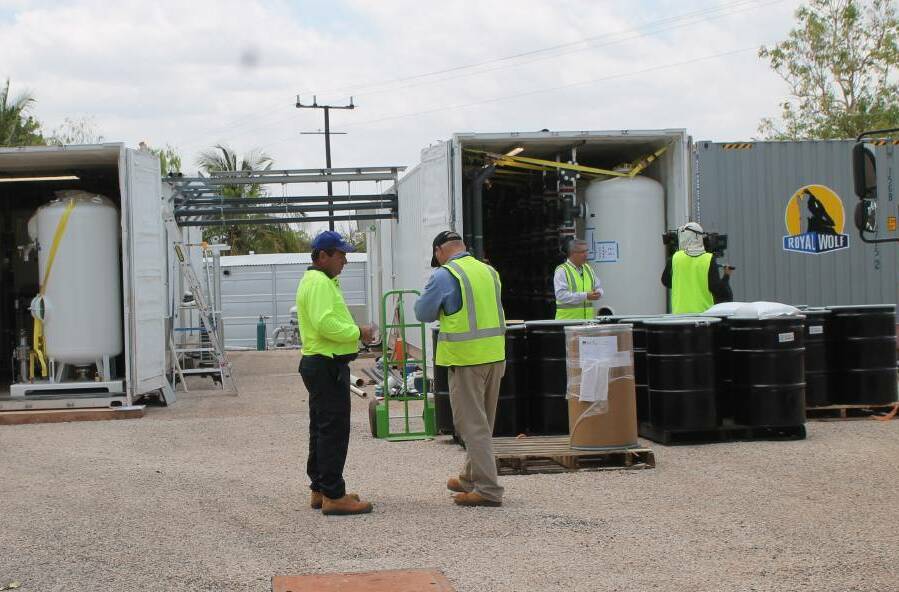
The Federal Government has crucially signed up to a nationally-agreed standard for dealing with PFAS clean up.
Subscribe now for unlimited access.
or signup to continue reading
Australia’s Environment Ministers have endorsed the country’s first PFAS National Environmental Management Plan.
The plan provides governments with a framework for the environmental regulation of PFAS-contaminated materials and sites.
The plan, released late Friday, is seen as crucial for Katherine where a clean up of the leaking Tindal RAAF Base is yet to begin.
PFAS residue removed from contaminated town bore water is being stored at the base.
The Department of Defence said up to 30 drums of waste will be stored at the base over the next year.
As well, 10 square metres of PFAS waste from the Katherine swimming pool’s filtration systems will be stored alongside the drums at the base.
Contaminated water from the town’s pool was sent to the town’s sewerage ponds.
The NT Government has said it has little jurisdiction over the storage of the toxic material as it is on Commonwealth land.
“The facility that the PFAS waste is stored at is on Commonwealth land and therefore the NT EPA does not have jurisdictional control or oversight in this regard,” an EPA spokesman said last year.
“Some PFAS have been globally identified as chemicals of high concern to human health and the environment, particularly due to their persistence and bioaccumulation,” the new plan says.
The report can be found here.
Environment Ministers agreed in 2016 that all jurisdictions have a critical role to play in developing nationally consistent standards for managing environmental contamination by PFAS.
Drafting of the plan began at the Environmental Regulators PFAS summit in Melbourne last year, hosted by EPA Victoria, on behalf of EPAs Australia and New Zealand, and the Australian Government Department of the Environment and Energy.
A meeting was held on the development of the plan in Darwin late last year.
The plan places standards on the transport of PFAS residue like that being taken from Katherine’s water treatment plant to Tindal, including the decontamination of vehicles and transport containers.
Construction of the toxic dumps require liners, engineered walls and “leachate collection and detection systems”.
Siting of the dump is expected to take into account –
- geology and hydrogeology
- community and stakeholder concerns
- sensitive receptors, such as key flora and fauna
- matters of national environmental significance and those protected by state and territory legislation
- surface water, including risks from extreme weather events and flooding
- existing contamination
- infrastructure
- ownership of the land
- local/state or territory regulations.
Stockholm Convention
The environmental guide also has lots to say about the gloabl Stockhold Convention, yet to be signed.
If Australia decides to ratify the listing of PFOS, its salts and PFOS-related chemicals on the Stockholm Convention on Persistent Organic Pollutants, or future listings of other PFAS, additional actions will be required to implement the globally accepted standards outlined in the Convention for the use and management of persistent organic pollutants.
The Australian Government is reviewing the remaining uses of PFOS, its salts and PFOS-related chemicals as part of the ratification process.
The objective of the Stockholm Convention is to protect human health and the environment from persistent organic pollutants. PFOS, its salts and PFOS-related chemicals were listed on Annex B (restriction) of the Stockholm Convention in 2009, with continued use permitted in some applications. The Australian Government Department of the Environment and Energy is conducting a treaty-making process to inform an Australian Government decision on ratification of the listing of PFOS. The treaty-making process includes analytical, consultative and parliamentary steps.
These steps are critical to ensure any management measures deliver the desired environmental outcomes, and that potential impacts (such as economic impacts on industry) are manageable. Public consultation was undertaken in late 2017 on the Regulation Impact
Statement of options for the national phase-out of PFOS in the context of the Stockholm Convention.
PFOA, its salts and PFOA-related chemicals were nominated in 2015 for listing on the Stockholm Convention, while PFHxS, its salts and PFHxS related chemicals were nominated in 2017. The earliest date for the Convention’s decision-making body to decide on the listing of PFOA is 2019. PFHxS was assessed against the Annex D criteria by the Convention’s subsidiary scientific body, the Persistent Organic Pollutants Review Committee, in October 2017.
The Committee concluded that PFHxS meets the screening criteria for persistence, bioaccumulation, potential for long range environmental transport and evidence for adverse impacts. It will proceed to the second of three technical review stages in 2018. Australia will continue to participate in the Convention’s processes and to address any domestic implementation requirements that may result if PFOA, PFHxS or other PFAS are listed.
Ratification of the PFOS listing or future listings of PFOA, PFHxS or other PFAS in the Stockholm Convention, would mean accepting international standards for the management of these chemicals.
For PFOS, this would include requirements regarding waste that contains PFOS at a level above 50 mg/kg.
The level is much higher than current requirements.


